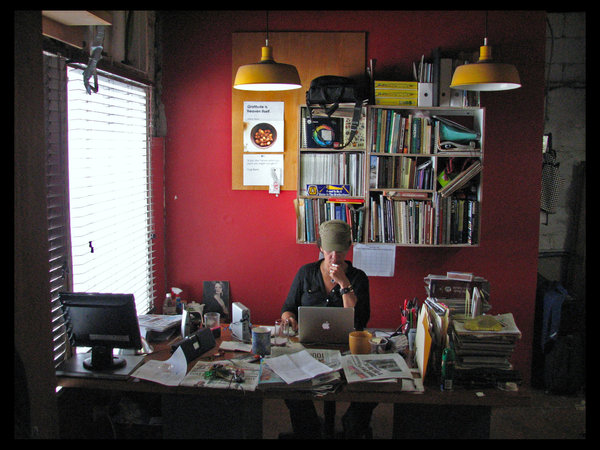Every day, millions of women spend 8-10 hours sitting in an office chair or desk in order to do their job. They think about getting that last report done, calling that client, impressing the boss, but what they may not think about is how their job might be a health risk. 14.6 million women have jobs in office administration or office support, and 9.2 million have jobs in management, business, or financial operations. An additional 8.2 million have sales or sales-related jobs that would require sitting at a desk for long periods. Though there are likely other health risks, I want to talk about the primary two of chronic neck pain and blood clots.
Neck Problems
It has been reported that the prevalence of neck pain in office workers is much higher than in the general population. The costs to the worker, employer, and society associated with work-related neck pain are known to be considerable and are escalating. If you work at a desk or computer for any length of time then I know you can agree with that statement. I know because I was one of you. I’d sit there for hours with horrible neck tension and fatigue. Eventually, I would get headaches from the ongoing strain on my vertebra. My chiropractor told me that the neck has some of the most mobile joints in the body; therefore, they can move inappropriately out of alignment easily when not taken care of.
Blood Clots
Another common problem posed for office workers is the threat of blood clots. Research suggests that workers who spend excessive amounts of time at their desk could be putting their lives at risk. The Medical Research Institute in New Zealand found they might have a higher risk of developing potentially fatal blood clots if they don’t take certain daily precautions. Because the clots can travel to the heart, lungs, or brain, causing chest pain, breathlessness or possible death from a heart attack or stroke, it is imperative that women take the time to move around and stretch their legs throughout the day. In addition, the researchers found a third of patients admitted to hospital with deep vein thrombosis (DVT) were office workers who spent hours at a computer.
So What Do I Do About It?
Taking the responsibility for your health is something that you must do at home and on the job. First, if there are things in your office that you know are hurting you like, an uncomfortable chair, a too-low desk, hard, concrete floors, etc., then you must talk to your supervisor about getting those items changed. If you end up missing work because of an injury caused by the work environment, they will ultimately be responsible; something they would avoid if they could. Second, you can take a few minutes a day to do some simple exercises that will make a difference in your overall health.
Try the following office fitness routine:
1. Arm Raise: This can be done while sitting or standing. Use a bottle of water for a weight or bring small dumb bells to work. Straighten your back and abs. Lift your arm up to shoulder level, hold for 3 seconds, and then up over your head. Hold. Repeat with your other arm.
2. Neck Stretches: A. Turn head slowly to the side as if you were trying to look at something over your shoulder and hold for 20 seconds. Repeat on the other side.
B. Tilt head toward your shoulder as if trying to touch it with your ear. Hold for 20 seconds. Make sure you do this slowly and with control. Your neck is sensitive and can be easily injured. If it hurts, you are stretching too hard. Repeat on the other side.
C. Bring head down as if trying to touch your chin to your chest and hold for 10 seconds. Then put your head back and look up at the ceiling for 10 seconds. Again, make sure you don’t strain to do this.
3. Bicep Curl: This can be done while sitting or standing. Use a bottle of water or your dumb bell. Straighten your back and abs. With your palm up, slowly curl your hand towards your shoulder. Repeat with you other arm.
4. Hip Flexion: Stand with your back, abs, and legs straight. Slowly lift your leg out to the side as high as you can and hold for 3 seconds. Use your arms for balance. Repeat this with your other leg.
5. Chair squat: Sit with your abs and back straight. Lift yourself about 6 inches off of your chair. Hold this position for as long as you can and then rest. Repeat.
6. Gluteus Squeeze: Sit in your chair with your back straight and abs pulled in. Squeeze your gluteus muscles (your butt) as hard as you can and hold for 5 seconds. Repeat 10 times. This exercise will increase blood flow to your lower body and therefore lowering the risk for blood clots.
7. Tricep Dip: This can be done at the edge of your desk. Place your hands on your desk next to your hips. Move your hips away from the desk and slowly lower your body until your arms reach a 90-degree angle. Raise your body up and repeat.
Extra Activities to Boost Office Fitness
- Park your car farther away from your office than usual. That way you can enjoy a quick walk before and after work.
- Take a break every hour to get up and move around. Also, try to find a flight of stairs to climb.
- Leave your lunch or something you need in your car, so you have to take a walk to go get it.
- Go for longer walks during your lunch break. Ask a co-worker to join you making it a fun, social time.
- Buy one of those stability balls and take it to work. You can spend part of your day sitting on the ball or simply use it on your lunch hour. Working On the Ball: A Simple Guide to Office Fitness, $9.99.
Final Thoughts
If you are feeling bad for any reason, tell your supervisor immediately as you may need to take a break. You should also talk to your health care provider before starting any exercise routine, especially if you have an illness or recent injury. Be proactive with your health and do what you can to boost your fitness level at work and home. All of these exercises can be done in your living room if you’re like me and work from home. Use a little creativity and develop your own routine that fits your work environment. Please send your thoughts and tips on this subject. And, remember, just do it!
Resources: Women in the Workforce, by Peter Rupert and Cara Stepanczuk; biomedcentral.com; Medical Research Institute in New Zealand; Momco.
Photo, Deep Thoughts by, Eye to Soul.
 Women's Life Link Be Well, Be Happy, Be YOU!
Women's Life Link Be Well, Be Happy, Be YOU!






2 comments
Pingback: Fun Online Stress Relievers | Women's Life Link
Pingback: Staying Fit With Limited Mobility | Womens Life Link